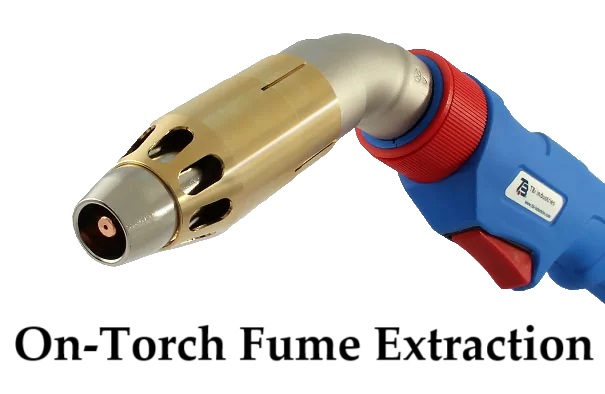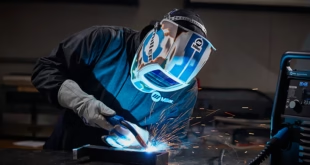On-Torch Extraction of Welding Fumes
Introduction to Welding Fumes and Safety Concerns
Welding is critical to various industries, from automotive manufacturing to construction and shipbuilding. However, welding processes release hazardous fumes that pose significant health and safety risks. Managing these fumes effectively is crucial for maintaining a safe work environment, particularly in enclosed or high-traffic areas where workers are consistently exposed to airborne contaminants.
What Are Welding Fumes?
Welding fumes are a mixture of tiny metal particles and gases produced during the melting and joining of metal materials. These fumes often include harmful substances like manganese, chromium, nickel, and other metals that can enter the lungs and bloodstream when inhaled. Unlike ordinary dust, these particles are extremely fine, allowing them to travel deeper into the respiratory system and settle in lung tissues. Understanding the composition of welding fumes is crucial for implementing the right safety measures.
Health Risks Associated with Welding Fumes
The inhalation of welding fumes is linked to numerous health issues, both acute and chronic. Short-term exposure can cause dizziness, nausea, throat and lung irritation, and headaches, while long-term exposure may result in severe conditions such as asthma, lung cancer, and neurological disorders. In addition, metals like manganese are known to cause neurological damage, leading to symptoms similar to Parkinson’s disease. This highlights why protecting welders from fumes is not just a regulatory requirement but a vital component of workplace safety.

Traditional Methods for Fume Extraction
Various fume extraction methods have been employed for decades to reduce welder exposure to hazardous fumes. These include local exhaust ventilation systems, portable extractors, and general ventilation systems. While each method has its strengths, they also present challenges that limit their effectiveness in certain work environments.
Overview of Common Extraction Techniques
Traditional fume extraction systems include:
- Local Exhaust Ventilation (LEV): These systems are usually fixed setups involving hoods positioned near the welding area to capture and extract fumes. LEVs are effective but limited by their stationary nature, which requires welders to work within a set proximity.
- Portable Fume Extractors: These devices offer more flexibility than fixed LEV systems. They can be moved closer to the welding site but require constant repositioning and sometimes only capture fumes in a limited area.
- General Ventilation Systems: These systems improve overall air quality but are generally less effective at removing fumes from the immediate vicinity of welders. They are often used in large workshops but cannot capture fumes directly at the source.
Limitations of Traditional Extraction Methods
Traditional methods come with certain limitations that can affect their efficiency:
- Position Dependency: LEV and portable extractors rely heavily on being placed close to the fume source. Any movement away from the extraction point reduces their effectiveness.
- Reduced Mobility for Welders: Traditional systems can hinder a welder’s freedom of movement, making it difficult for them to work efficiently in areas with restricted space.
- High Maintenance and Operating Costs: These systems require regular maintenance and often have significant energy demands, making them costly over time, especially in larger facilities with multiple extraction points.
Understanding On-Torch Extraction
On-torch extraction represents an innovative approach to welding fume management, capturing fumes right as they are generated. This method is more efficient in certain settings and offers welders increased mobility compared to conventional fume extraction methods.
What Is On-Torch Extraction?
On-torch extraction integrates the fume extraction nozzle directly into the welding torch, capturing fumes as they are produced at the weld pool. By positioning the extraction point so close to the source, this method minimizes the dispersal of fumes, allowing welders to maintain a cleaner and healthier environment with minimal equipment.
How On-Torch Extraction Works
On-torch extraction systems use a high-powered vacuum system connected to a specially designed torch. As the welder works, fumes are captured through a nozzle at the torch’s end and directed into a filtration system. The filters trap toxic particles and contaminants, releasing clean air back into the workspace. By effectively capturing fumes at the source, on-torch extraction can minimize exposure to hazardous substances and reduce the need for additional ventilation equipment.
Benefits of On-Torch Fume Extraction
The on-torch extraction approach offers several advantages over traditional fume extraction methods. By directly addressing the limitations of older systems, on-torch extraction contributes to a safer, more efficient, and more environmentally friendly workplace.
Enhanced Safety and Health for Welders
The primary benefit of on-torch extraction is the improvement in welder health and safety. Because fumes are captured directly at the torch, welders are exposed to far fewer airborne contaminants. This direct capture method drastically reduces the concentration of hazardous substances in the breathing zone, effectively lowering the risk of respiratory issues and long-term health conditions.
Improved Efficiency and Productivity
On-torch extraction systems eliminate the need to reposition extraction equipment, giving welders greater freedom of movement. With fewer obstructions around the welding site, welders can perform tasks more efficiently. This added flexibility results in time savings, especially in complex welding projects where maintaining proper fume extraction can be time-consuming.
Reduction in Environmental Impact
On-torch extraction contributes to a cleaner environment by preventing hazardous fumes from being released into the atmosphere. Many regulatory bodies have set strict limits on fume emissions, so this method helps companies comply with environmental standards. Additionally, on-torch extraction systems are often energy-efficient, making them a sustainable choice for workplaces looking to reduce their carbon footprint.
Types of On-Torch Extraction Systems
On-torch extraction systems come in different types, tailored to varying welding processes and environments. The two primary categories are high-vacuum and low-vacuum systems, each suited to specific work conditions.
High-Vacuum vs. Low-Vacuum Extraction
- High-Vacuum Extraction: These systems create a powerful suction to capture fumes in smaller, enclosed spaces or for precise welding tasks. They work well in settings where targeted fume extraction is needed, offering strong capture power with minimal energy usage.
- Low-Vacuum Extraction: Low-vacuum systems are suitable for larger areas with broader fume dispersion. These systems capture fumes over a wider area, making them ideal for larger workshops or open spaces where fumes tend to spread more.
Features of Modern On-Torch Extraction Systems
Today’s on-torch extraction systems are equipped with advanced features to enhance usability, such as:
- Adjustable Nozzles: These can be positioned precisely to maximize fume capture without affecting the welding arc.
- Energy-Efficient Designs: Many systems are built with energy-saving mechanisms, allowing them to run efficiently without consuming excessive power.
- Enhanced Filtration: Modern systems come with multi-layered filters that trap even the finest particles, ensuring higher air quality and reducing the need for frequent filter changes.
Key Components of an On-Torch Extraction System
For on-torch extraction systems to function effectively, they must include high-quality components. Knowing these parts can aid in proper maintenance and troubleshooting, ensuring consistent performance.
The Role of the Extraction Nozzle
The extraction nozzle is designed to capture fumes directly from the weld pool. Its placement and design are essential for effectively capturing contaminants without disturbing the welding process. Proper positioning and regular cleaning of the nozzle are necessary to maintain optimal fume capture.
Filter Units and Air Quality Control
Filters trap hazardous particles, preventing them from being reintroduced into the workspace. Most systems feature replaceable filter cartridges, with some using multiple filters to capture a range of particle sizes. Regular filter replacement is crucial to maintain air quality and prevent blockages that reduce suction power.
Maintenance Essentials for Optimal Functioning
Routine maintenance is necessary to keep on-torch extraction systems performing at their best. This includes cleaning the nozzle, inspecting hoses for wear, and regularly replacing filters. Preventive maintenance minimizes downtime and extends the system’s lifespan, ensuring a reliable fume extraction solution.
On-Torch Extraction vs. Local Exhaust Ventilation (LEV) Systems
On-torch extraction systems are often compared to traditional LEV systems, each having distinct advantages and disadvantages. Comparing these two can help facilities choose the best option for their specific needs.
Comparing Efficiency and Effectiveness
On-torch extraction captures fumes directly at the source, making it more effective in applications where immediate fume removal is critical. LEV systems, while efficient, rely heavily on positioning and may not capture all fumes, particularly in larger or open areas where fumes can spread quickly.
Cost and Maintenance Differences
Though on-torch extraction systems often have a higher initial cost, they require less frequent maintenance and consume less energy over time compared to LEV systems. LEV systems may be more affordable upfront but can accrue higher costs in the long run due to more extensive maintenance requirements and energy consumption.
Challenges in Implementing On-Torch Extraction Systems
Despite their benefits, on-torch extraction systems have certain limitations that may affect their practicality in some workplaces.
Practical Considerations in Different Work Environments
On-torch extraction systems may not suit all types of welding environments, particularly in cases where access to certain parts of the weld is restricted. Additionally, specialized training is often required to ensure that welders are comfortable using the system, which can be a barrier in large-scale operations.
Addressing System Limitations and Drawbacks
Some on-torch extraction systems are heavier than traditional torches, which can increase welder fatigue. However, modern designs are increasingly focused on reducing weight and improving ergonomics to address these concerns. Ongoing research and development aim to minimize these drawbacks.
Future of On-Torch Extraction Technology
The field of fume extraction is constantly evolving, with new technologies emerging to enhance both effectiveness and ease of use.
Emerging Innovations in Fume Extraction
Research is focused on creating more efficient filters, advanced nozzles, and automated maintenance alerts. Future systems may include self-cleaning nozzles, AI-driven maintenance scheduling, and even real-time air quality monitoring to help welders stay informed about their exposure levels.
Predictions for the Welding Industry
As regulations tighten and awareness of occupational health risks grows, more companies are expected to adopt on-torch extraction systems. The welding industry is moving towards creating healthier workplaces, and on-torch extraction systems will likely play a vital role in achieving this.
FAQs
What materials are safe for on-torch extraction?
On-torch extraction is generally compatible with metals like steel and aluminum. However, certain materials might require specific adjustments or additional filtering.
How does on-torch extraction impact welding performance?
With proper calibration, on-torch extraction improves weld visibility by reducing fume density without impacting weld quality.
Is on-torch extraction suitable for all welding types?
It’s highly effective for MIG and TIG welding but may be less effective in high-heat welding like stick welding.
What maintenance is required for on-torch extraction systems?
Regular filter cleaning, nozzle checks, and inspections keep the system functioning well.
How does on-torch extraction compare in cost to traditional methods?
While initial costs are higher, on-torch extraction generally provides cost savings through reduced maintenance and increased productivity.
Conclusion
On-torch extraction of welding fumes is a groundbreaking advancement in welding safety and efficiency. By capturing fumes at the source, these systems provide unmatched protection for welders, enhance productivity, and contribute to environmental responsibility. For any welding facility seeking to prioritize health, safety, and compliance, on-torch extraction systems are an invaluable investment.
 Welding of Welders All about Welding and Welders
Welding of Welders All about Welding and Welders



